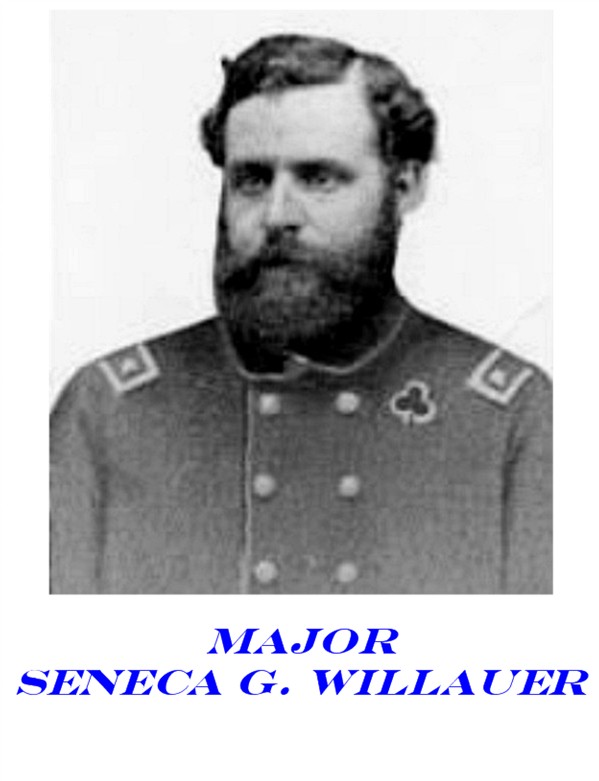|
CIVIL WAR FIELD OFFICERS SWORD – IRON HILT VARIANT
WITH A PATRIOTIC MOTIF ON THE GUARD AND THE BEAUTIFULLY
ETCHED BLADE – IDENTIFIED TO MAJOR SENECA G. WILLAUER,
116TH PENNSYLVANIA INFANTRY, AND THE VETERANS
RESERVE CORPS: This Civil War Iron Hilt Field
Officer’s Sword has survived in very nice condition.
Obtained years ago from the family descendants, this
sword belonged to Major Seneca Grubb Willauer of the 116TH
Pennsylvania Volunteer Infantry, and later, after
recovering from his severe wounds suffered at the Battle
of Fredericksburg in 1862, he served in the 6TH and
11TH Regiments, Veterans Reserve Corps.
Stationed in Maryland at the end of the war, Willauer
was involved in the capture of John Wilkes Booth, the
infamous assassin.

This sabre was recently purchased from a very large, old
Eastern collection and that collector purchased this
sabre from an antique dealer who was a descendant of
Major Willauer. As is so often the case, the surviving
descendants no longer had an interest in keeping the
sabre within the family and the collector just happened
to be in the right place at the right time to acquire
it. While the sabre is not engraved with the major’s
name, an early biography of his service dating back to
1892 accompanied the sabre, supplied by the family
member.
Major Willauer (b.11-24-1833, d. 11-25-1916) left quite
a record, and with a minimal amount of effort some
highlights of his military service was found. The 116TH
Pennsylvania Infantry Regiment was formed during the
summer of 1862 and by September had moved to Washington,
D.C. and then south into Virginia. The regiment
participated in the Battle of Fredericksburg, December
12-15, and it was during this battle when Willauer was
severely wounded on the 13TH. Leading his
company as they assaulted Marye’s Heights, Willauer was
“hit by a shell that tore all the flesh from his thigh,
exposing the bone.” Willauer’s reaction to the wound
was so notable that his utterance has been recorded in
several histories of the regiment and the battle. In
spite of the seriousness of the wound, Willauer
reportedly sought out the regiment’s colonel and asked,
“Do you think I should go on with my company or go to
the hospital?” Such presence of mind under fire and
while coping with what anyone would reasonably assume to
be a debilitating injury is the stuff from which legends
are born and history is written, and it continues to
serve as a testament of the caliber and character of the
soldier to who it is attributed. He was cited for
gallantry at Fredericksburg and promoted to captain upon
the recommendation of his regiment’s colonel and with
the endorsement of General Hancock.

From available information, Willauer apparently
recovered sufficiently from his wound to return to and
remain with the 116TH . He was recommended
for the lieutenant-colonelcy of the regiment, but the
ranks of the regiment were so depleted due to losses at
Fredericksburg that the regiment could not be mustered.
While new recruits were sought to replenish the ranks,
the regiment remained in northern Virginia and Willauer
served as the regiment commander until February of
1864. At that time he was promoted to captain, and then
brevetted to the rank of major in conjunction with his
transfer in April to the 6TH Regiment of the
Veteran Reserve Corps (VRC), and in December to the 11TH
Regiment, VRC.
While in command of a significant detachment of the 11TH
Regiment, VRC stationed in Leonardtown, Maryland,
Willauer actively participated in the pursuit and
capture of John Wilkes Booth and David Herold, two of
the Lincoln conspirators.
Willauer remained on active duty after the war, serving
in a variety of posts, to include an assignment in
Alexandria, Louisiana where he was credited with a
considerable effort in establishing schools for the
freed slave children. He retired from active duty in
1868 and returned to Pennsylvania. In 1869 he was
elected as the chief court clerk of Chester County,
during the 1870’s and 1880’s he was the owner of the
Kaolin Mine and Mill in Caln Township, and as late as
the 1900 US Census he was listed as an inspector of the
Pennsylvania Soldiers’ Orphan Schools.
The Willauer family did not entirely escape the tragedy
of the Civil War, and in fact, the war service of
Seneca’s immediate family illustrates the cost of the
war on both sides of the Mason-Dixon Line. On the same
day Seneca was wounded on Marye’s Heights, his younger
brother Sam, a corporal in the same Company C of the 116TH
, sustained wounds from which he eventually died. A
second brother, Jonathan, had visited their sister in
Texas during the 1850’s and stayed to establish a
ranch. When the war broke out, Jonathan joined the 21ST
Texas Cavalry and was killed in 1864 in Louisiana while
serving the Confederacy.
The pre-war 1850 regulations called for company grade
officers to carry the Foot Officers Sword and staff and
field grade officers were to carry the aptly named Staff
and Field Officers sword. As with all of the other
pieces of uniform, equipment, and weapons, the officers
were expected to outfit themselves at their own
expense. While the regulations applied to regular and
state militia officers alike, a considerable amount of
latitude was afforded the officer, with his preferences
and financial situation dictating his choices as much
(if not more so) as the regulations.
This non-regulation Staff and Field Officer’s Sword was
assembled and sold by the firm of George W. Simons
Brothers & Company of Philadelphia, and so marked on the
ricasso of the blade with a legible etched panel as
clear as the day it was applied, “GEV. W. SIMONS, BROS
PHILADELPHIA”. That Major Willauer would purchase his
sword from a retailer located in Pennsylvania comes as
no surprise, and Simons was a well established firm,
dating from the 1840’s, and by 1861 the company was
offering swords. It is believed this company
“assembled” swords and sabres, rather than
“manufacturing” them - the distinction being that Simons
purchased the components from various sources and
assembled the parts into complete swords and sabres for
sale.
This particular style of sword is well documented in
Peterson’s The American Sword on pages 83-84, and
pictured on pages 74-75 of Echoes of Glory, Arms and
Equipment of the Union from the Time-Life series.
The iron guard is full form with no misshaping or
breaks, and has an overall bright surface with only
minimal spots of darkening, and no severe pitting. The
grip is surmounted by a checkered backstrap which
expands to form a bird’s head pommel cap decorated with
concentric rings, and at the grip base is a ferrule with
matching concentric rings. The ribbed grip retains the
full pebbled ray skin covering and the correct wrapping
of three strands of twisted wire is tight and fully
intact, and shows very minimal evidence of use or wear.
The sheet iron guard features three branches and the
counter guard is highlighted with an impressive cut out
decoration which features the Federal eagle perched on
the bundle of arrows and olive branches laid across the
letters “U.S.”. The eagle is surmounted by a ribbon
scroll bearing the motto “E PLURIBUS UNUM”. The cut out
is very well executed and the figure of the eagle,
central shield, and the bundles of arrows and branches
are all chased with fine engraved details.
This sword retains what appears to be the original black
leather sword knot which has survived in remarkable
condition. While showing some signs of age and use, the
doubled braided wrist strap is full length with only
minor wear and no breaks. The strap has a single
overhand knot which has been in place for a very long
time, and was probably applied by Willauer in order to
adjust the length of the strap to suit his use. The
sliding braided leather keeper is present, and the
terminal braided and fringed acorn or knot is present.
The terminal knot still retains most of the jagged-edged
fringe pieces and the braided band around the top of the
knot is fully intact. Sword knots were not particularly
durable and that this knot survived in place and intact
is remarkable in and of itself, and it is a very nice
added value feature of this sword.
The blade surface is very smooth and overall bright.
The edge is smooth with no nicks and no sign of heavy
sharpening. The tip of the blade has retained the
original profile and length. The obverse side of the
blade has an etched panel framed in a floral pattern
with a central design of the federal eagle surmounted by
the “E Pluribus Unum” ribbon scroll perched the bundles
of arrows and olive branches. The reverse side of the
blade has an etched panel framed in a floral pattern
with a centrally positioned bold “US” with floral
highlights around the letters. The etching on both
sides is very bright and legible with no darkening or
frosting. The back of the blade, immediately adjacent
to the ricasso, is etched “IRON PROOF” within a panel.
The ricasso is marked on the obverse as stated above,
with the maker’s name etched in a panel. That same
panel also includes a stamped recess which is gilded and
bears the stamp “PROVED” surmounting a Maltese cross.
The reverse ricasso bears an etched panel stamped with a
figure of an armored knight and “W. CLAUBERG” above the
figure and “SOLINGEN” below, indicating the blade’s
maker.
The scabbard is full form, with a complete throat, both
carrying rings, a solid seam with no splits, a drag in
the original shape with no excessive wear, and has an
overall bright surface with minimal scattered spots of
darkening, with no severe pitting.
The sale of this sword is accompanied by a body of
biographical material documenting Major Willauer’s life,
to include copies of the original letter documenting his
Civil War service; copies of photographs of the major
beginning with a portrait taken during the war and two
images taken later in life; copies of original documents
written by or to the major; and a collection of
biographical material gleaned from various sources.
This is not only an excellent example of the iron guard,
non-regulation Staff and Field Officers Sword, but it
enjoys the additional value that attaches from the
identification to a Pennsylvania officer who served, and
was severely wounded, in one of the most famous
engagements of the Civil War. Major Willauer’s service
both during war and to his community upon his return to
civilian life will make this sword a pleasure to own.
These identified sabres do not surface often, and once
retired from the market into a collection, it will lie
quietly for many years to come.
SOLD
|

